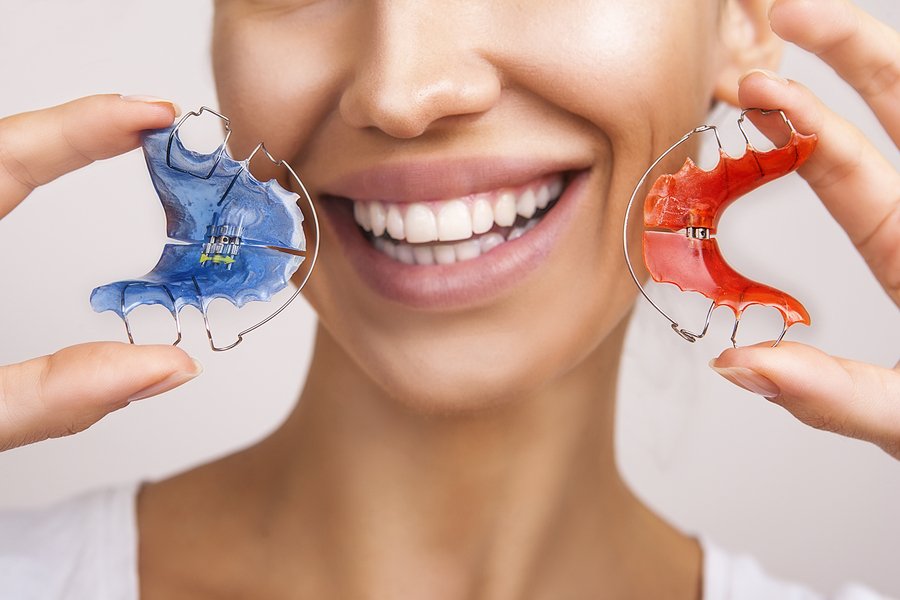After you’ve completed your initial orthodontic treatment, you’ll probably be celebrating your new smile. It’s still important to remember, however, that this isn’t the end of your orthodontic treatment. You will still have to wear retainers for a year or more to keep your teeth from shifting back to their previous positions.
Your orthodontist will take impressions of your mouth and send them to a lab to have retainers created for you. You will need to wear your retainers for at least a year or more. After your braces treatment, you’ll be happy to know that you can remove your retainer when eating, drinking, or going out for a special evening. But you’ll also have to take care of your retainer for the duration of your treatment.
Here are some tips for keeping your retainer in good shape:
Why is Retainer Hygiene Important?
Your retainers are in close contact with your teeth and gums. Because your mouth is a warm, moist environment, it is easy for bacteria to contaminate the surface of your retainers. This bacteria can produce unpleasant odors that may lead to bad breath. In addition, a dirty retainer may end up contributing to gum disease.
How Often Should I Clean My Retainer?
You should thoroughly clean your retainer at least once a day, preferably immediately before inserting it into your mouth. At minimum, rinse your retainer before putting it back in your mouth after every meal and give it a thorough cleaning once per day.
How to Clean Retainers
One of the easiest ways to clean your retainers is to brush them at the same time that you brush your teeth, both morning and evening. Use a soft bristle brush to clean your retainers: itisn’t safe to use toothpaste with all retainers, so ask your orthodontist about this. Some may recommend using baking soda as a natural cleanser and disinfectant.
How to Deep Clean Retainers
You can also deep clean your retainer by soaking it in an antibacterial solution. Some mouthwashes work well for this purpose, but you should follow your orthodontist’s recommendations. The best retainer cleaners will kill bacteria without damaging the plastic. Never use bleach or rubbing alcohol to clean your retainer, as this can cause damage.
How to Remove Plaque from Retainers
Since plaque is a sticky biofilm, you will need to scrub it away using a soft-bristled toothbrush. You can also kill and loosen the bacteria by soaking the device in an antibacterial solution. Don’t expose your retainer to high heat by putting it in the dishwasher or soaking it in very hot or boiling water. High temperatures can affect its shape and ruin its effectiveness.
How to Clean Invisalign Retainers
Rinse your Invisalign retainer under lukewarm water that isn’t too cold or too hot. Apply toothpaste to a retainer brush or standard soft-bristled toothbrush. Using gentle, circular motions, brush the entire Invisalign retainer, both inside and out.
Look for white stuff on the retainer, which indicates the presence of calcium (tartar) build-up. If you see any, soak the device in a retainer or denture cleaning solution according to the manufacturer’s instructions. Invisalign makes a cleansing product specifically designed for Invisalign retainers, but any denture or cleansing solution will get the job done.
How to Clean Metal Retainers
Metal retainers affixed to the teeth require special flossers. You can ask your dentist or orthodontist which ones they recommend; but most drug stores or grocery stores sell orthodontic flossers that can loosen particles from around your retainers. Gentle brushing and antibacterial mouthwash should be enough to keep your metal retainers clean. If not, ask your dentist for recommendations based on your unique needs.
How Long Do Retainers Last?
Retainer treatment typically lasts anywhere from 1 to 3 years, and the appliance itself may last for two years or more. Your orthodontist will inspect your retainer when you come in for visits and let you know if it needs to be replaced.
In some cases, your orthodontist may recommend wearing your retainer during the evenings, or even just a few nights a week, for a period of time beyond the normal 1-3 years. If this is the case, you and your orthodontist can discuss an appropriate schedule for wearing the retainer, office visits, and replacements.
How Can You Avoid Losing Your Retainer?
Replacing a lost retainer can be expensive, so it’s best to take steps to avoid losing it. The easiest way to prevent retainer loss is to wear it constantly, only taking it out to clean it or when you are eating.
When you do remove your retainer, put it into its container. This is not only a polite gesture toward those who may be dining in your vicinity, but it also helps guard against loss. Never wrap your retainer in a napkin, as it is easy for you, or a server, to end up dumping the wrapped retainer into the trash.
Avoid putting your retainer in a shirt or pants pocket. In addition to the risk of forgetting about it and putting it into the laundry, there is also a greater chance of damaging the retainer as you go about your day. The wires are especially vulnerable to being bent or broken, so be sure to tuck the retainer in its container as soon as you remove it.
Don’t Let Your Retainer Dry Out
High heat and carelessness are two of the most common ways that a retainer can become damaged. Another way to damage a retainer is to let it dry out. The retainer should be kept somewhat moist at all times. You can accomplish this by wearing it as frequently as possible. When you can’t wear it, soak it in a glass of antibacterial liquid if you are at home. If you are out and about, store your retainer in its container, preferably rinsing it with clean water beforehand.
The Importance of Regular Dental and Orthodontic Treatment
Orthodontic treatment doesn’t end after you get your braces off. Your orthodontist will want to see you periodically to check on your progress and make adjustments to your retainer as necessary. Keep in touch with your orthodontist’s office. If there is a change in your contact information, let the office staff know about it so that they can send you an appointment reminder where you are sure to receive it.
It’s also important that you schedule regular checkups and cleanings with your dentist. Your orthodontist or regular dentist can advise you as to the optimal frequency of these appointments. Because this stage of your treatment can last a long time, you may end up moving before your time wearing a retainer has completed. In such cases, let your orthodontist know of your plans and make arrangements to have your records transferred to another dental professional near your new home.
Final Word
If you are thinking about orthodontic care, contact your neighborhood Gentle Dental. Our staff includes orthodontists, giving you one central location for all of your oral health needs. We offer convenient appointment scheduling, including evening and weekend hours, and offer multiple payment options, including insurance, discount programs, major credit card acceptance, and financing plans.
Get closer to your perfect smile. Book your next appointment at a Gentle Dental location near you.


 Previous Article
Previous Article

